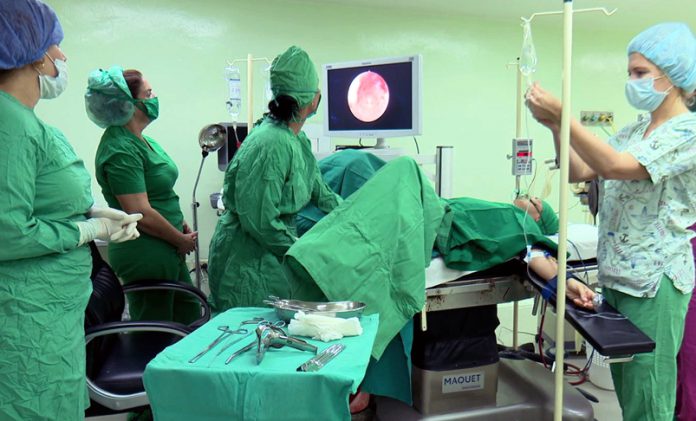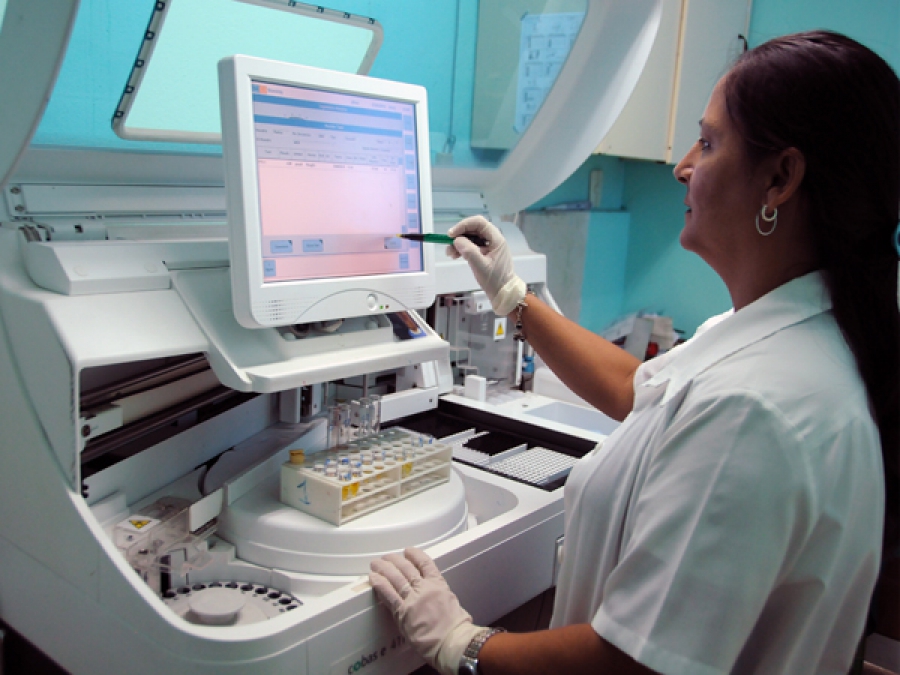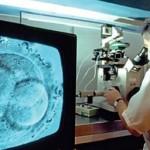Infertility Treatment in Cuba
Latest News:
New diagnostic technique introduced in the Center for Assisted Reproduction of Cienfuegos
 Hyshteroscope is a device that allows to explore the uterine cavity, by means of the endoscopic technique, favorably influences the diagnoses of patients of the Center of Assisted Reproduction of Cienfuegos in Cuba. Newly installed optical system is connected to an external monitor, equipment that facilitates the diagnosis by interpreting images of the interior of the uterus, in search of complex fertility disorders. The procedure is minimally invasive, it involves the introduction of an optical device a few millimeters in size, through the vagina and cervix, to expand and clean the cavity, administering saline. This diagnostic and therapeutic technique is used to verify the quality of endometrium, evaluate the uterus, and rule out tumors or other anomalies, among the causes of female infertility. Performing it on an outpatient basis, in a short time and with high certainty, constitute other benefits of the practice. There is also the possibility that it is used for therapeutic purposes: if necessary, the specialist removes small polyps or tumors, and proceeds to taking biopsies.
Hyshteroscope is a device that allows to explore the uterine cavity, by means of the endoscopic technique, favorably influences the diagnoses of patients of the Center of Assisted Reproduction of Cienfuegos in Cuba. Newly installed optical system is connected to an external monitor, equipment that facilitates the diagnosis by interpreting images of the interior of the uterus, in search of complex fertility disorders. The procedure is minimally invasive, it involves the introduction of an optical device a few millimeters in size, through the vagina and cervix, to expand and clean the cavity, administering saline. This diagnostic and therapeutic technique is used to verify the quality of endometrium, evaluate the uterus, and rule out tumors or other anomalies, among the causes of female infertility. Performing it on an outpatient basis, in a short time and with high certainty, constitute other benefits of the practice. There is also the possibility that it is used for therapeutic purposes: if necessary, the specialist removes small polyps or tumors, and proceeds to taking biopsies.
Need Extra Money? Try this
Cuba the first in the world to eliminate mother-to-child HIV transmission
 The World Health Organization (WHO) certified Cuba as the first country in the world to meet the double challenge of eliminating mother-to-child transmission of HIV and syphilis. After several decades of research failed to yield an effective cure, breaking the vicious cycle that perpetuates the virus presents a tremendous challenge. But that is exactly what Cuba has done. Every year, about 1.4 million women with HIV get pregnant worldwide. If they do not receive treatment, there is a 15- to 45-% chance of them transmitting the virus to their babies during pregnancy, birth, or while breastfeeding. Eliminating transmission of a virus is one of the greatest public health achievements possible and the WHO officially recognized the Caribbean nation's achievement.
The World Health Organization (WHO) certified Cuba as the first country in the world to meet the double challenge of eliminating mother-to-child transmission of HIV and syphilis. After several decades of research failed to yield an effective cure, breaking the vicious cycle that perpetuates the virus presents a tremendous challenge. But that is exactly what Cuba has done. Every year, about 1.4 million women with HIV get pregnant worldwide. If they do not receive treatment, there is a 15- to 45-% chance of them transmitting the virus to their babies during pregnancy, birth, or while breastfeeding. Eliminating transmission of a virus is one of the greatest public health achievements possible and the WHO officially recognized the Caribbean nation's achievement.
Infertility Treatment in Cuba: Strong Scientific Approach, Skilled Folks, Heavy Demand
 Infertility treatment is associated with a high risk of neonatal morbidity and mortality basically with prematurity and a low birth weight increasing markedly in newborns conceived by this procedure of assisted reproduction. In Cuba they carried out a huge amount of research to identify the morbidity and mortality of this group and the differences in some indicators of hospital morbidity with those naturally conceived. A transversal, prospective and descriptive study was conducted including 49 neonates conceived by in vitro fertilization (IVF) technique. As a result rate of multiple pregnancies and of cesarean section was high in those conceived by IVF compared with remainder live births (27% versus 1.4%; p < 0.000 and 97.3% versus 40.9%; p < 0.000, respectively). Most of neonates were term born (71.4%), with a good weight (61.2%) and with a eutrophication nutrition assessment (85.7%). The 28.5% showed morbidity with predominance of a severe icterus 20,4%); the 6.1% deceased (two from hyaline membrane disease and one from intraventricular hemorrhage). There was a higher ratio of prematurity, low weight, restricted intrauterine growth, hyaline membrane disease, congenital malformations and neonatal mortality in those conceived by IVF ( p < 0.05) in all of them. Key advantage for an IVF treatment in Cuba is that the newborn artificially conceived have significant influence in hospital indicators related to neonatal morbidity and mortality of institutions where they are seen, thus, hospitals with this responsibility need a logistic support and differentiated health objectives.
Infertility treatment is associated with a high risk of neonatal morbidity and mortality basically with prematurity and a low birth weight increasing markedly in newborns conceived by this procedure of assisted reproduction. In Cuba they carried out a huge amount of research to identify the morbidity and mortality of this group and the differences in some indicators of hospital morbidity with those naturally conceived. A transversal, prospective and descriptive study was conducted including 49 neonates conceived by in vitro fertilization (IVF) technique. As a result rate of multiple pregnancies and of cesarean section was high in those conceived by IVF compared with remainder live births (27% versus 1.4%; p < 0.000 and 97.3% versus 40.9%; p < 0.000, respectively). Most of neonates were term born (71.4%), with a good weight (61.2%) and with a eutrophication nutrition assessment (85.7%). The 28.5% showed morbidity with predominance of a severe icterus 20,4%); the 6.1% deceased (two from hyaline membrane disease and one from intraventricular hemorrhage). There was a higher ratio of prematurity, low weight, restricted intrauterine growth, hyaline membrane disease, congenital malformations and neonatal mortality in those conceived by IVF ( p < 0.05) in all of them. Key advantage for an IVF treatment in Cuba is that the newborn artificially conceived have significant influence in hospital indicators related to neonatal morbidity and mortality of institutions where they are seen, thus, hospitals with this responsibility need a logistic support and differentiated health objectives.
All about Infertility treatment to time-schedule the trip and stay in Cuban clinic
Although only one stage comes to mind when infertility treatment is mentioned, the journey on which people embark with the goal of bringing a "live baby home" is comprised of various stages. Here are all the processes that take place in infertility treatment from the very first test to determining the pregnancy and the actual birth. Treatment for infertility should first address any underlying medical condition that may be contributing to fertility problems. Drugs, surgery, or both may be used to treat these conditions. Surgery may also be used to repair blockage in fallopian tubes.

Infertility doesn't discriminate, but infertility treatment does. A lot of women go through IVF when they are over 40. Sometimes it takes years before they get pregnant the first time. In Vitro Fertilization, or IVF, is the most effective form of assisted reproductive treatment, but in many countries that chance comes at an extraordinary cost and is pushing normal, everyday people into illegally online black market dealing in order to save money on leftover fertility drugs. Some families spend about $45,000 in order to try and conceive their children and have to come up with all that money out-of-pocket because most insurance plans don't cover infertility treatment. The lack of coverage leaves families determined to have a baby naturally with few options: Pay tens of thousands of dollars out of pocket, take out high interest loans, or worse, decide they can't afford to try. That's why Cuba is a viable option in order to be able to afford and access treatment. Just click "Buy now" button to download the file with both Cuban IVF clinic and best clinic in Eastern Europe contact data and soon you'll be pleasantly surprised by the value we provide.
EUR 5.- ONLY best hi-end in-budget clinic Britts herd for IVF, ICSI and surrogation contacts. + Cuban IVF contacts included.
Avoid-Middlemen Option Contacting Cuban Clinics

Any person wishing to design the treatment program on his own can buy the clinic's of his choice contact details to talk to the attending phisician prior to make any kind of travel arrangements.
Some particular topics you would like advice on need a consultation by a professional. We encourage foreign patients to contact Cuban clinics directly avoiding middlemen. There are four high-end fertility treatment centres all over the island. But still IVF and ICSI for foreigners is a very complicated topic to discuss with a Cuban clinic. However we advice foreign couples to pick up a clinic in Havana.
Besides Cuba is particularly recommended for reproductive risk factors control in men and women with diabetes
Diabetes Impacts Female Fertility. Women who have diabetes are also at a greater risk for having issues with conceiving. There are many factors that can contribute to lower rates of fertility: obesity, being underweight, having diabetic complications, having PCOS (polycystic ovary syndrome), or having an autoimmune disease. The following conditions are associated with diabetes in women and generally lead to reduced fertility rates:
PCOS – This is a common condition in which a large number of cysts develop on the ovaries and can affect fertility by leading to irregular or absent periods. PCOS is largely associated with type 2 diabetes and obesity.
Irregular or absent periods – Periods are considered irregular when they arrive at intervals of 35 days or more between cycles. Periods are considered absent when a woman previously had a normal cycle but stopped getting a period for 6 months or longer.
Premature menopause – Primarily associated with type 1 diabetes, premature menopause is defined when a woman stops getting a period prior to the age of 40.
Endometrial cancer (uterine cancer) – This disease is more common in women with type 2 diabetes and PCOS and can lead to infertility if not treated at an early stage.
Microvascular and cardiovascular complications – Studies show that women with type 1 diabetes who experience microvascular or cardiovascular complications have much lower rates of fertility.
Fertility Treatment Approaches
Several approaches are used to treat infertility:
· Lifestyle measures (healthy lifestyle, planning sexual activity with ovulation cycle, managing stress and emotions)
· Drugs to induce ovulation, such as clomiphene and gonadotrophins
· Assisted reproductive technologies (ART) such as in vitro fertilization (IVF) or intracytoplasmic sperm injection (ICSI)
When investigating the causes of infertility whether ovulation is taking place must first be established. A variety of tests are used to determine this. One of the indications of ovulation is regular menstruation cycles. However measuring the progesterone (the sex hormone that is secreted from the ovaries) level on the 21-24th day of the cycle produces a clearer result. Then whether or not the uterus and fallopian tubes are anatomically normal must be established and in order to do this ultrasonographic examinations and x-rays of the uterus can be used.
The first of the tests that can be run on men, which is the spermiogram, counts the sperm and examines their mobility and structure. These assessments give information about the male's infertility. If problems are detected in the couple, various treatments are given accordingly.
When the IVF is applied
When one or both individuals in the couple have infertility issues it is necessary to start IVF treatment. Here are some such causes:
Tubal factor: If the woman's fallopian tubes are not functional or severely deformed anatomically the couple resort to in-vitro fertilization to have a baby.

The Ovarian reserve: The ovarian reserve in women begin to decline after 30 years of age. This speeds up after 35 and increases as of 40. In order to examine the ovary reserve, a measurement of FSH and E2 hormones can be done on the third day of a period and of AMH hormone on any given day of the period. Also an ultrasound can count antral follicles (ovarian cysts). Patients with an advanced case of decreased reserves must start IVF without delay.
Ovulation disorders: When a variety of ovulation treatments that are applied for a certain amount of time towards ovulation disorders do not result in achieving a pregnancy, IVF can be resorted to.
Unexplained infertility: When the reason for the infertility is not known, taking into account the woman's age and degree of infertility either intrauterine insemination is applied first or IVF is applied directly.
Male infertility: Sperm concentration, mobility and structure are examined and intrauterine insemination and IVF are applied to those who do not respond to urological treatment.
Stages of IVF treatment
The first stage in the in-vitro treatment is to stimulate the woman's ovaries. During this method that is called "Controlled ovarian hyperstimulation" the ovaries are stimulated to develop follicles. The stimulation, which is achieved through various agents and protocols, lasts about 8-14 days in the short protocols that are frequently applied today.
Later the eggs are triggered by the HCG hormone to mature. 34-36 hours after the HCG hormone injection, the eggs are harvested. This process is done by the transvaginal method entering the patient's ovaries with the help of an ultrasound and aspirating the follicles with a special needle. Embryologists examine the aspirated follicle liquid in the laboratory and determine the number of eggs that have been harvested.
On the same day that eggs are harvested from the woman, sperm is taken from the man. After this sperm sample goes through a special cleansing process the best sperm are singled out.
The maturation of the eggs is assessed. The mature eggs in the "Metaphase 2" period are fertilizable. The selected sperm are injected into these eggs by microinjection. While in previous years the sperm had been left next to the egg for fertilization to take place, in the present days the microinjection method called ICSI is preferred. The sperm cells are placed directly inside the egg under a microscope.
The fertilized eggs are placed in an incubator that provides the conditions and heat that they need to develop. The gas and humidity is adjusted and the eggs, which are placed inside a special liquid, are monitored. 16-18 hours must go by before it can be determined whether the insemination has been successful or not. The results can be obtained from the first check that is done at the end of this period.
If the insemination is successful, it is followed by the cell division of embryo. The embryo consists of about 4 cells in 36-48 hours and 8 cells in 72 hours. On the fifth day the embryo is classified as a blastocyst.
The embryo transfer is usually done on the third or fifth day with the help of special catheters but recently the fifth day is being favored. The reason for this is that the rate of selecting the best embryo and the rate of the embryo in blastocyst stage latching onto the uterus is higher. However if not enough good quality embryos have been achieved there is no need to wait for the fifth day. The process of positioning the embryo in the uterus can also be done with three-day embryos that have shown sufficient development.
Once the transfer is completed the female patient is released after a 30-60 minutes of bed rest. During this period patients are warned not to do anything that requires a lot of physical effort, not to lift heavy items or do high impact exercises. The patient must use the medications that have been prescribed on time, eat well and drink plenty of fluids.
11-12 days after the transfer blood tests are done to detect pregnancy. Women who test positive for Beta HCG are tested again in a few days to check the increase of the hormone level. Later an ultrasonography is done. In 7-10 days after the test it is possible to see a gestational sac in the cervix using an ultrasonography. Thus the clinic can determine whether the pregnancy has taken place or not.
Success rates in IVF
Presently a success rate of about 55-60 percent per transfer can be achieved in IVF, but of course the real success is regarded as the rate of actually "taking home a live baby". This rate varies by age. It is 40-45 percent in women under 30, 30-35 percent in women 35 to 37 years old, 20-25 percent in women aged 38-40, 12-15 percent in women 41-42 and 4-5 percent in women over 42.
Choosing a Fertility Clinic
Some doctors recommend that if a couple fails to conceive after 1 - 2 years of frequent unprotected sex, they should consult a fertility expert. Women who are 35 or older, however, may want to begin exploring their options if they do not become pregnant within 6 months to a year.
Choosing a good fertility clinic is important. Those offering assisted reproductive techniques are not always regulated by the government, and abuses have been reported, including lack of informed consent, unauthorized use of embryos, and failure to routinely screen donors for disease.
The clinic should always provide the following information:
· The live-birth rate (not just pregnancy success rate) for other couples with similar infertility problems. (Multiple births, such as twins or triplets, are counted as one live birth.)
· Such statistics should include high-risk women, such as those who are older or fail to produce eggs. (Some disreputable clinics give success percentages that exclude high-risk women from their total, thereby making the percentage of success much higher.)
Advanced fertility procedures and medications are extremely expensive and often not covered by insurance. Couples should be cautious about offers of rebates in the event of failure; the clinics offering them are often significantly more expensive than those that don't offer such gimmicks.
Erectile Dysfunction (ED) Treatment in Cuba
Erectile malfunction is difficulty experienced by an individual during any stage of a normal sexual activity, including physical pleasure, desire, preference, arousal or orgasm. The dysfunction requires a person to feel extreme distress and interpersonal strain for a minimum of 6 months (excluding substance or medication-induced erectile dysfunction). These dysfunctions can have a profound impact on an individual's perceived quality of sexual life.
Erectile Dysfunction treatment program in Cuba can also be performed as an outpatient service.
Evaluation of male sexual dysfunction program includes:
- 4 nights of hospitalization (The Hospitalization will include accommodation in a private room, nursing care and medical assistance, evaluation and preparation of medical history, as well as three course meals).
- Specialized medical Interconsultation of psychology
- Clinical laboratory studies:
–Hemoglobin
–Hematocrit
–Erythrocyte sedimentation rate (ESR).
–differential Leucogram
–quantitative serology
–HIV
–Glycemia
–Cholesterol
–Triglycerides
–Testosterone
–Follicle stimulating hormone (FSH)
–Luteinizing Hormone (LH)
–Prolactin
–Penile-brachial index at rest and after exercise
–Penile Doppler with prostaglandin
-conduction velocity of dorsal penile nerve
Special Considerations for Patients with Cancer
 Women who are undergoing cancer treatments and who want to become pregnant should see a reproductive specialist to discuss their options. According to the American Society of Clinical Oncology's guidelines, the fertility preservation method with the best chance of success is embryo cryopreservation. This procedure involves harvesting a woman's eggs (oocytes), followed by in vitro fertilization and freezing of embryos for later use. Other treatments under investigation include egg preservation, collecting and freezing unfertilized eggs, removing and freezing a part of the ovary for later reimplantation, and using hormone therapy to protect the ovaries during chemotherapy. Women may be able to access these investigational approaches through enrolling in clinical trials.
Women who are undergoing cancer treatments and who want to become pregnant should see a reproductive specialist to discuss their options. According to the American Society of Clinical Oncology's guidelines, the fertility preservation method with the best chance of success is embryo cryopreservation. This procedure involves harvesting a woman's eggs (oocytes), followed by in vitro fertilization and freezing of embryos for later use. Other treatments under investigation include egg preservation, collecting and freezing unfertilized eggs, removing and freezing a part of the ovary for later reimplantation, and using hormone therapy to protect the ovaries during chemotherapy. Women may be able to access these investigational approaches through enrolling in clinical trials.
Some Gynaecological and Urological Minimum Access Surgeries Costs in Cuba
Minimum access surgery technique that consists in performing the operative surgery through small orifices to extirpate several organs and carry out a number of surgical procedures, without making a large surgical wound.
| Pathology | Intervention | Stay at hospital | Anesthesia | Price (CUC) |
| Bilateral varicocele | Ligation of spermatic vessels | 3 | GA | 1983.00 |
| Suprarenal tumor | Videoendoscopy Suprarenalectomy | 12 | GA | 5673.00 |
| Uterine pathology due to various causes | Laparoscopy-assisted vaginal hysterectomy | 7 | GA | 3493.00 |
| Paraovarium cyst | Exeresis of the cyst by unilateral laparascopic surgery | 3 | GA | 1983.00 |
| Multicyst ovaries | Section of ovaries by laparascoy | 3 | GA | 1883.00 |
| Ovaran tumor | Unilateral oophorectomy | 3 | GA | 1983.00 |
| Pelvic endometriosis | Contrasted videolaparoscopy. Vaporization of the endometrium foci by Argon plasma | 3 | GA | 1803.00 |
| Castration | B?lateral oophorectomy | 3 | GA | 2183.00 |
| Unilateral hydrosalpinx | Unilateral salpingectomy | 3 | GA | 1983.00 |
| Bilateral hydrosalpinx | Bilateral salpingectomy | 3 | GA | 2183.00 |
| lnfertility of tubal origin | Contrasted videolaparoscopy with unilateral plastic surgery of tubes | 3 | GA | 2253.00 |
| lnfertility of tubal origin | Contrasted videolaparoscopy with bilateral plastic surgery of tubes | 3 | GA | 2353.00 |
| Anterior tubal sterilization | Contrasted laparoscopy. Terminoterminal anastomosis of tubes by microsurgery | 7 | GA | 2713.00 |
| Multiparity | Sterilization by laparascopy | 2 | GA | 1378.00 |
| Tubal pregnancy | Salpingectomy | 2 | GA | 1723.00 |
| Ectopic pregnancy | Videolaparoscopy with unilateral salpingectomy | 3 | GA | 1813.00 |
| Study of infertility in female | Contrasted videolaparoscopy | 5 | GA | 3036.00 |
| Study of infertility o male | Outpatient | GA | 540.00 |
Legend:
| GA: | General Anesthesia | LA: | Local Anesthesia | RA: | Regional Anesthesia |
Gynaecology Specialized consultation
This checkup is carried out in out-patient consultation for a promotional price of $320.00 CUC and includes:
Clinical Laboratory Investigations:
Complete Haemogram
Erythrosedimentation
Quantitative Serology (VDRL)
HIV
Microbiological and Gynaecological investigations
Vaginal Cytology
Colposcopy
Simple Vaginal Exudate
MENOPAUSE CHECK UP IN CUBA:
Women over 45 should carry out regular specialized checkups to ensure the health of reproductive system, even when the reproductive years are over. Natural hormonal changes can mask the onset of diseases that once diagnosed early, can be easily treated or cured. If symptoms of menopause are a concern for you, Cuban specialists can provide treatments and alternatives than will help ease you through this stage of your life.
This checkup is carried out in out-patient consultation for a promotional price of 600.00 CUC and includes:
Gynecology Specialized re-consultation
Clinical Laboratory Investigations:
Estrogen
FSH
LH
Complete Haemogram
Erythrosedimentation
Quantitative Serology (VDRL)
Total lipids
Microbiological and Gynecological investigations:
Vaginal Cytology
Colposcopy
Simple Vaginal Exudate
Imagenologic Investigations:
Ultrasonographic Bone Densitometry|
Diagnostic transvaginal ultrasound
Ultrasound of Breasts and mammogram


